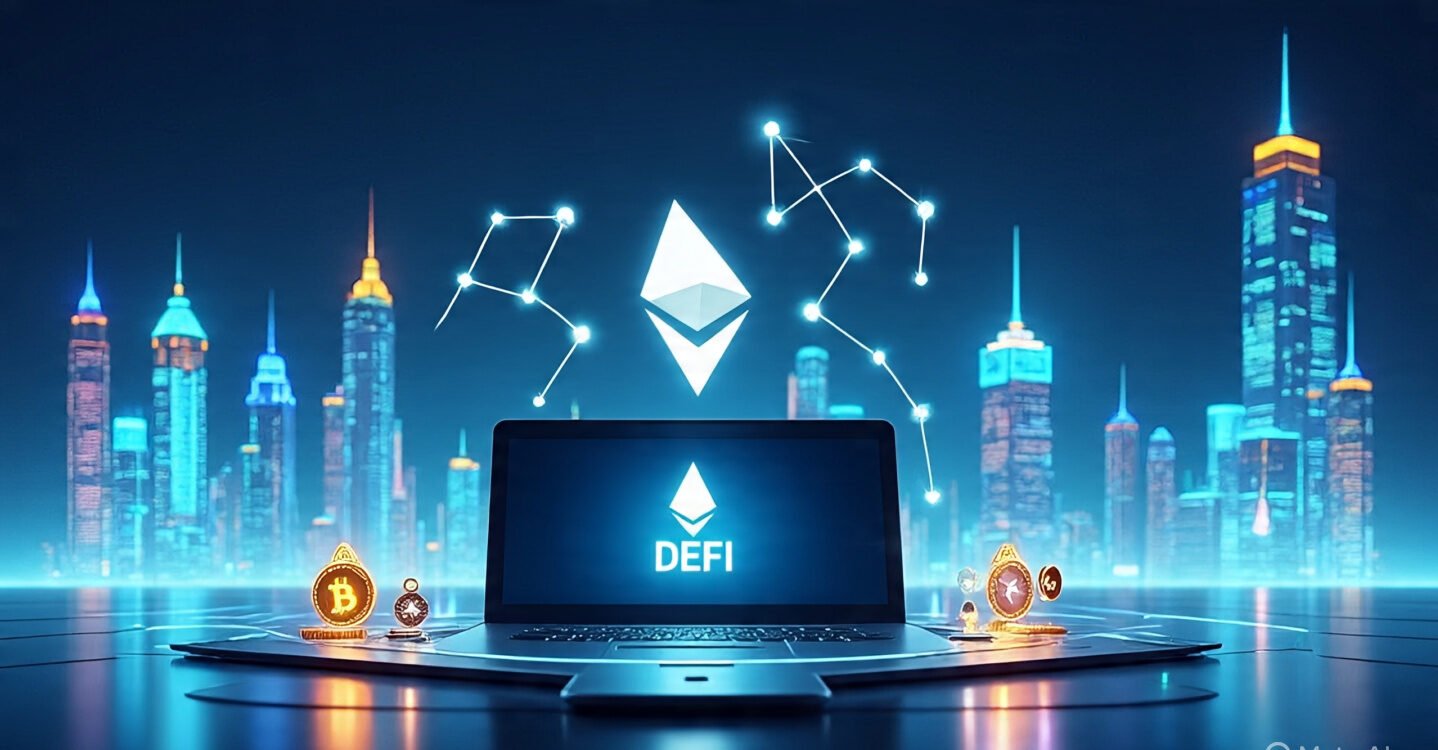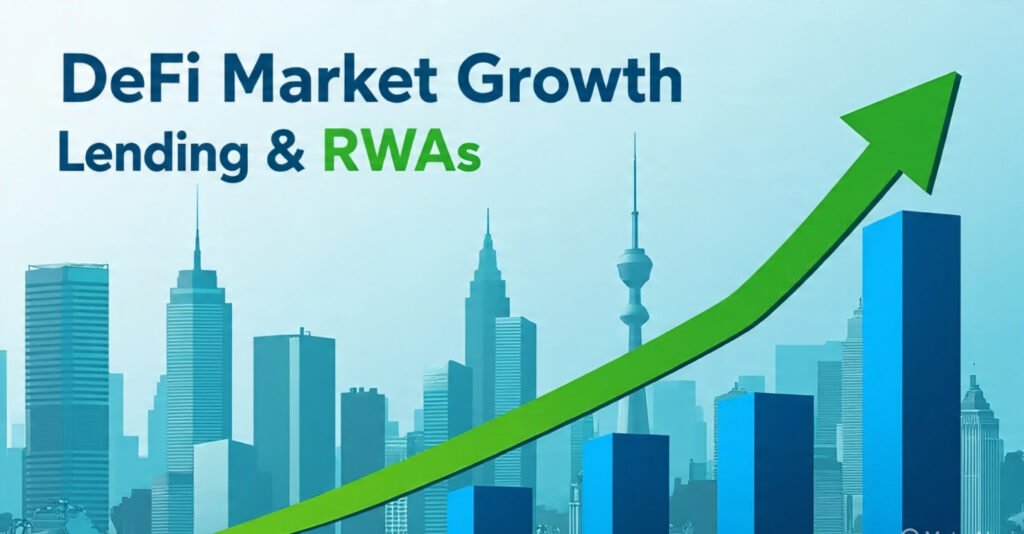DeFi market growth approaches record-breaking territory. This remarkable expansion is being fueled by three critical pillars: innovative lending protocols, the tokenization of real-world assets (RWAs), and the explosive adoption of stablecoins. As traditional financial institutions increasingly recognize the potential of blockchain-based financial services, the DeFi Market growth trajectory suggests we’re witnessing a fundamental shift in how global finance operates.
Recent data indicates that total value locked (TVL) across DeFi protocols has surged dramatically, with lending platforms, RWA tokenization projects, and stablecoin ecosystems leading this charge. This surge in decentralized finance expansion represents not just numerical growth, but a maturation of the entire ecosystem that’s attracting institutional investors, retail users, and regulatory attention worldwide.
The Current State of DeFi Market Growth
Record-Breaking Total Value Locked
The DeFi market growth phenomenon is best illustrated by examining the total value locked across various protocols. As of late 2024, the combined TVL has reached extraordinary heights, with several key metrics pointing toward sustained expansion. DeFi lending protocols alone account for nearly 40% of this total, demonstrating the massive appetite for decentralized borrowing and lending solutions.
This growth isn’t merely speculative; it represents real utility and adoption. Users are increasingly turning to DeFi platforms for yield generation, borrowing against crypto assets, and accessing financial services that traditional banks either don’t provide or offer at prohibitive costs. The decentralized lending platforms have become sophisticated enough to compete directly with traditional financial institutions in terms of user experience and security.
Institutional Adoption Accelerates DeFi Expansion
Perhaps the most significant driver of DeFi market growth has been the entry of institutional players. Major corporations, hedge funds, and even traditional banks are now exploring DeFi protocols for treasury management, yield generation, and innovative financial products. This institutional adoption validates the sector’s maturity and provides the liquidity necessary for sustained growth.
Blockchain finance growth has also been supported by improved regulatory clarity in key jurisdictions. As governments develop comprehensive frameworks for digital assets, institutional confidence in DeFi protocols has increased substantially, leading to larger capital allocations and more sophisticated use cases.
DeFi Lending Protocols: The Foundation of Growth
Evolution of Decentralized Lending Platforms
DeFi lending protocols have evolved far beyond simple peer-to-peer lending models. Today’s platforms offer sophisticated features, including flash loans, undercollateralized lending for verified entities, and integration with traditional credit scoring systems. These innovations have expanded the addressable market significantly, contributing to overall DeFi market growth.
The lending sector’s success stems from its ability to offer superior yields compared to traditional savings accounts while providing borrowers with access to capital without the bureaucratic hurdles of traditional banking. Decentralized lending platforms typically offer annual percentage yields (APYs) that are multiples of what traditional banks provide, attracting capital from yield-seeking investors globally.
Real-World Assets: Bridging Traditional and Digital Finance
The RWA Revolution in DeFi
Real-world assets tokenization represents one of the most promising frontiers in DeFi market growth. By bringing traditional assets like real estate, commodities, stocks, and bonds onto blockchain networks, RWA protocols are creating unprecedented opportunities for both asset owners and DeFi users.
The tokenization of real-world assets addresses one of DeFi’s longstanding challenges: the need for yield-generating assets that aren’t correlated with crypto market volatility. RWA tokenization projects now offer exposure to stable, income-generating assets while maintaining the efficiency and accessibility benefits of DeFi protocols.
Institutional Assets Enter DeFi Ecosystem
Major asset managers and traditional finance companies are increasingly exploring how to tokenize their holdings and integrate them into DeFi lending protocols. This trend is creating massive opportunities for blockchain finance growth as trillions of dollars in traditional assets become eligible for DeFi integration.
The regulatory framework around real-world assets tokenization continues to evolve, with many jurisdictions now providing clear guidelines for how traditional assets can be legally tokenized and traded on blockchain networks. This regulatory clarity has been essential for institutional adoption and continued DeFi market growth.
Stablecoins: The Infrastructure of DeFi Growth
Stablecoin Adoption Fuels Market Expansion
Stablecoin adoption has been perhaps the most critical factor in DeFi market growth. These digital assets, which maintain stable value relative to reference assets like the US dollar, provide the price stability necessary for sophisticated financial operations within the DeFi ecosystem.
The total market capitalization of stablecoins has grown exponentially, with major issuers now managing hundreds of billions of dollars in assets. This growth provides the liquidity foundation that enables DeFi lending protocols and other DeFi applications to scale effectively.
Central Bank Digital Currencies and DeFi Integration
The development of central bank digital currencies (CBDCs) presents both opportunities and challenges for DeFi market growth. While some CBDCs may compete with existing stablecoins, others are designed to integrate with DeFi protocols, potentially providing even greater legitimacy and adoption for decentralized finance expansion.
Several central banks are actively exploring how CBDCs can work within existing DeFi lending protocols and other decentralized applications. This integration could accelerate blockchain finance growth by providing government-backed digital currencies that can be used seamlessly within the DeFi ecosystem.
Technology Innovations Driving DeFi Market Growth
 Layer 2 Solutions and Scalability
Layer 2 Solutions and Scalability
The implementation of Layer 2 scaling solutions has been crucial for DeFi market growth. These technologies have dramatically reduced transaction costs and increased transaction throughput, making DeFi applications accessible to a broader user base. Decentralized lending platforms can now serve retail users economically, not just high-net-worth individuals and institutions.
Cross-chain interoperability protocols have also expanded the potential user base for DeFi lending protocols. Users can now access DeFi services regardless of which blockchain network their assets are on, creating a more unified and efficient decentralized finance expansion.
Artificial Intelligence and Smart Contract Optimization
The integration of artificial intelligence into DeFi lending protocols has improved risk assessment, yield optimization, and user experience significantly. AI-powered systems can analyze vast amounts of on-chain and off-chain data to make lending decisions that would be impossible for human underwriters to process efficiently.
These technological improvements have made decentralized lending platforms more competitive with traditional financial institutions while maintaining the transparency and accessibility advantages that define DeFi. This technological edge continues to drive DeFi market growth by attracting users who demand both innovation and reliability.
Regulatory Environment and Future Outlook
Global Regulatory Developments
The regulatory landscape for DeFi market growth continues to evolve rapidly. Major jurisdictions including the United States, European Union, and Asia-Pacific regions are developing comprehensive frameworks for DeFi regulation. These developments provide the legal certainty necessary for continued institutional adoption and blockchain finance growth.
Real-world assets tokenization has received particular regulatory attention, with many jurisdictions now providing clear guidelines for how traditional assets can be legally brought onto blockchain networks. This regulatory clarity has been essential for institutional adoption of RWA protocols.
Compliance and KYC Integration
Modern DeFi lending protocols are increasingly integrating know-your-customer (KYC) and anti-money laundering (AML) compliance systems. While this may seem to contradict DeFi’s decentralized ethos, it’s proven essential for institutional adoption and regulatory compliance. These systems allow decentralized lending platforms to serve regulated entities while maintaining their core efficiency advantages.
The development of privacy-preserving compliance solutions allows DeFi lending protocols to meet regulatory requirements without compromising user privacy or the permissionless nature of blockchain networks. This balance has been crucial for sustaining DeFi market growth in regulated markets.
Investment Strategies and Market Opportunities
Yield Farming and Liquidity Mining
DeFi market growth has created sophisticated yield farming and liquidity mining opportunities that didn’t exist in traditional finance. These mechanisms allow users to earn returns by providing liquidity to DeFi lending protocols and other DeFi applications. The yields available through these strategies often exceed what’s available through traditional investments.
Decentralized lending platforms have gamified the lending and borrowing experience through token rewards and governance participation. These incentive mechanisms have been crucial for bootstrap liquidity and driving early decentralized finance expansion.
Risk-Adjusted Returns in DeFi
Sophisticated investors are now analyzing DeFi lending protocols using the same risk-adjusted return metrics applied to traditional investments. Many DeFi strategies now offer superior risk-adjusted returns compared to traditional alternatives, particularly when considering the improved liquidity and 24/7 market access that DeFi provides.
The integration of real-world assets tokenization has provided DeFi investors with access to previously illiquid asset classes. This access has improved portfolio diversification opportunities and contributed to overall DeFi market growth by attracting traditional investors seeking yield and diversification.
Future Trends and Market Predictions
Institutional DeFi Products
The development of institutional-grade DeFi products will likely accelerate DeFi market growth significantly. These products combine the efficiency advantages of DeFi lending protocols with the compliance, custody, and risk management features that institutional investors require.
Blockchain finance growth will likely be driven by the creation of hybrid products that bridge traditional and decentralized finance. These products will allow institutions to access DeFi yields while maintaining compliance with existing regulatory frameworks and internal risk management requirements.
Cross-Chain DeFi Integration
The future of DeFi market growth will likely involve increased integration across different blockchain networks. Decentralized lending platforms are already working on cross-chain solutions that allow users to access the best yields and features regardless of which blockchain network they prefer.
 This cross-chain integration will expand the total addressable market for DeFi lending protocols and create more efficient capital allocation across the entire decentralized finance expansion. Users will be able to optimize their strategies across multiple networks without the current friction of manual bridge transactions.
This cross-chain integration will expand the total addressable market for DeFi lending protocols and create more efficient capital allocation across the entire decentralized finance expansion. Users will be able to optimize their strategies across multiple networks without the current friction of manual bridge transactions.
Challenges and Risk Considerations
Smart Contract Risks and Security
Despite significant improvements in security practices, DeFi lending protocols still face smart contract risks that don’t exist in traditional finance. The immutable nature of blockchain transactions means that bugs or vulnerabilities can have severe consequences for users and protocol developers.
However, the DeFi community has developed sophisticated tools for smart contract auditing, formal verification, and risk management. These tools have significantly reduced the frequency and severity of security incidents, supporting continued DeFi market growth by maintaining user confidence.
Regulatory Uncertainty
While regulatory clarity has improved significantly, DeFi market growth still faces uncertainty in many jurisdictions. Changes in regulatory frameworks could impact how decentralized lending platforms operate and which users they can serve.
The industry is actively working with regulators to develop frameworks that protect consumers while preserving the innovation and efficiency advantages of blockchain finance growth. This collaborative approach has been essential for maintaining positive regulatory momentum.
Market Data and Performance Metrics
TVL Growth and User Adoption
Current DeFi market growth metrics demonstrate unprecedented user adoption and capital allocation. The number of unique addresses interacting with DeFi lending protocols has grown exponentially, while the average transaction size has also increased significantly.
Decentralized finance expansion is no longer limited to crypto-native users. Traditional finance professionals, institutional investors, and retail users from various demographics are now actively participating in DeFi lending protocols and other DeFi applications.
Geographic Distribution and Global Access
DeFi market growth has been particularly pronounced in regions with limited access to traditional banking services. Decentralized lending platforms provide financial services to users who would otherwise be excluded from the traditional financial system, contributing to financial inclusion globally.
The 24/7, permissionless nature of DeFi lending protocols has created a global marketplace for yield and borrowing that operates across time zones and jurisdictions. This global access has been a key driver of blockchain finance growth and will likely continue to expand the addressable market.
Conclusion
The DeFi market growth we’re witnessing today represents more than just a financial trend—it’s a fundamental transformation of how global finance operates. The convergence of innovative DeFi lending protocols, real-world assets tokenization, and widespread stablecoin adoption has created an ecosystem that offers superior efficiency, accessibility, and innovation compared to traditional financial systems.
As decentralized lending platforms continue to mature and institutional adoption accelerates, the decentralized finance expansion trajectory suggests we’re still in the early stages of this transformation. The integration of artificial intelligence, improved scalability solutions, and clearer regulatory frameworks will likely drive continued blockchain finance growth for years to come.
For investors, institutions, and users considering DeFi participation, the current market conditions present unprecedented opportunities to benefit from DeFi market growth. However, success requires understanding the risks, staying informed about regulatory developments, and choosing established DeFi lending protocols with strong security track records.

